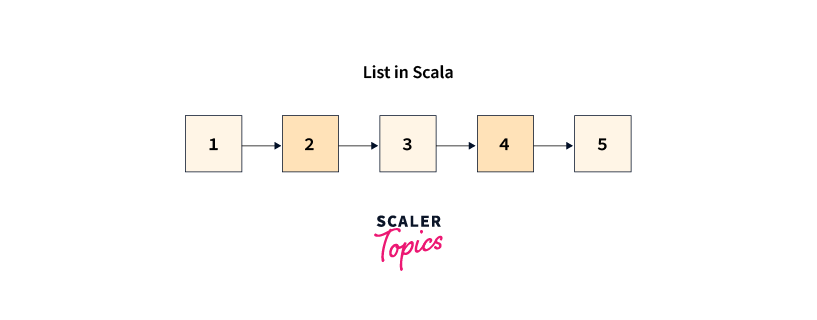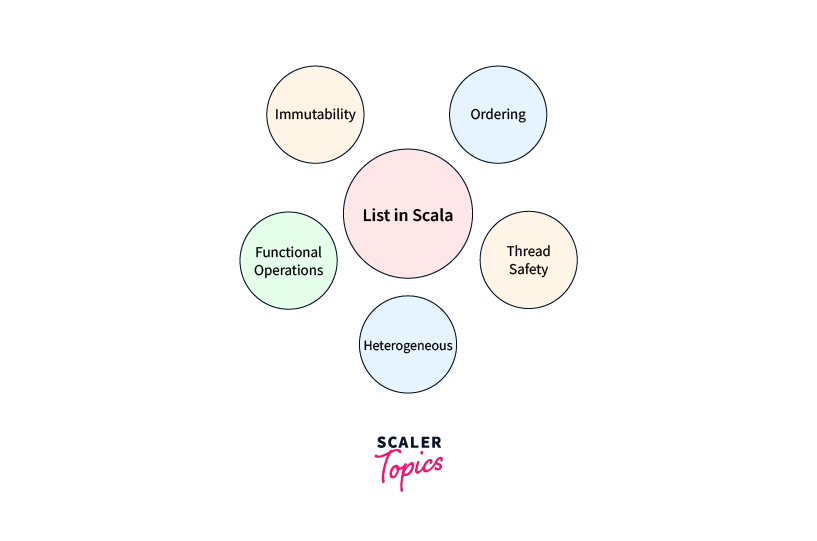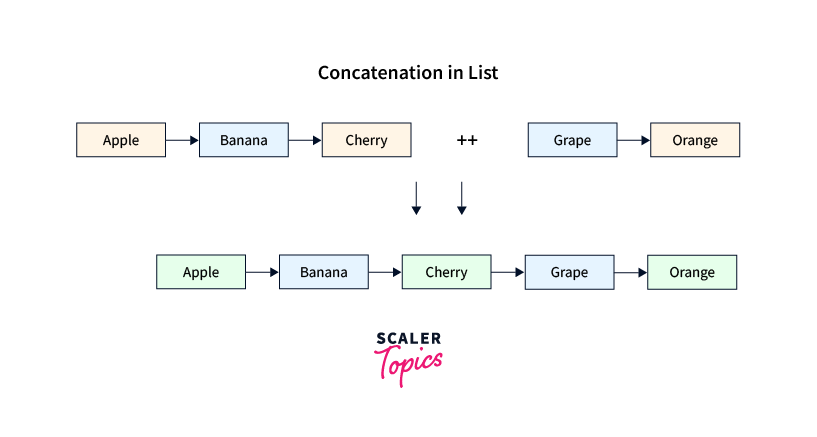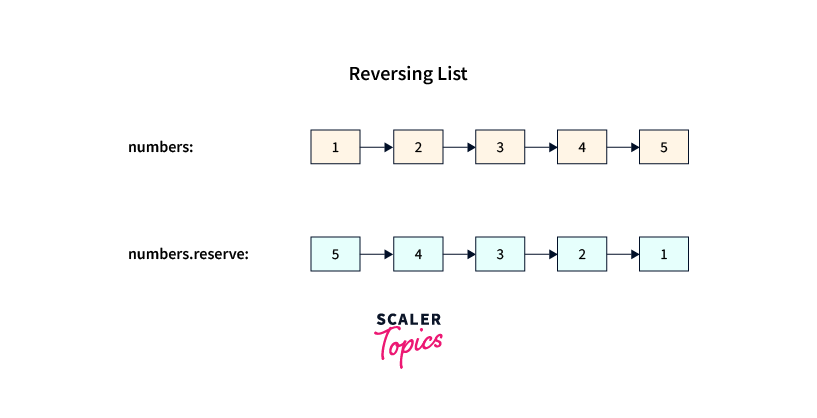Scala Lists
Overview
A list in Scala is an ordered collection of elements, where each element can be of the same or different types. Lists can be either immutable, ensuring data integrity and promoting functional programming, or mutable, allowing in-place modifications for performance. Immutable lists are widely used for safe data transformation, functional pipelines, and thread safety. Mutable lists are useful when efficiency or in-place changes are required.
Syntax
Scala provides two distinct types of lists: mutable and immutable.
We can create an immutable list using the List constructor or the shorthand notation:
Syntax:
For mutable lists, we use the ListBuffer class:
Syntax:

Some Important Points About List in Scala
Here are some important points to understand about lists in Scala:
- Ordered Collection:
Lists maintain the order in which elements are added, ensuring that elements are retrieved and processed in the same sequence. - Immutable by Default:
Scala's default list implementation is immutable, meaning that once a list is created, its elements cannot be changed. This promotes functional programming principles and reduces the risk of unintended side effects. - Mutable Alternative:
Scala also offers mutable lists through the ListBuffer class. These mutable lists allow efficient in-place modifications, which can be beneficial in scenarios where performance is critical. - Flexible Element Types:
Lists can contain elements of the same or different types, providing flexibility in storing heterogeneous data. - Pattern Matching:
Lists can be conveniently deconstructed using pattern matching, enabling us to extract and process elements easily. - Thread Safety:
Immutable lists inherently provide thread safety, making them suitable for concurrent programming without the risk of data corruption due to simultaneous modifications. - Performance Considerations:
- Immutable lists provide thread safety and encourage side-effect-free programming.
- Mutable lists can be useful in performance-critical scenarios where in-place updates are required.
- Conversions:
- Mutable to Immutable:
We can convert a mutable list to an immutable one using the toList method. - Immutable to Mutable:
Converting to mutable lists often involves copying elements.
- Mutable to Immutable:

Basic Operations on Lists
| Operation | Description |
|---|---|
| Creating Lists | Lists are formed using the List constructor or shorthand :: notation. The constructor initializes an immutable list, while the shorthand prepends elements to an existing list. |
| Accessing Elements | We can access elements in a list using the head method to retrieve the first element and the tail method to obtain the rest of the elements. |
| Adding Elements | To add elements, we use the :+ operator to append an element to the end of an immutable list. The ++ operator is used to concatenate two lists |
| Transformations | Transformation operations modify the elements in a list using methods like map, filter, etc. |
| Removing Elements | To remove elements from a list, we can use the filterNot operation to help filter the elements of the list that satisfy the condition. |
| Size | We can obtain the size using the size or length methods. |
| Pattern Matching | Pattern matching allows us to destructure and process the elements of a list. Pattern matching helps in differentiating between an empty list (Nil) and a list with elements. |
| Conversion | We can convert mutable to immutable lists with toList for data integrity. |
Concatenating Lists
Concatenating lists involves combining two or more lists into a single list while preserving the order of elements. In Scala, we can achieve list concatenation using the ++ operator.

Example:
Output:
Explanation:
- In this example, we defined two lists fruitsList1 and fruitsList2 containing fruit names. We then used the ++ operator to concatenate these two lists into a new list called combinedFruitsList.
- Next, we defined another list fruitsList3 with additional fruit names for demonstarating multiple list concatenation. We concatenated all three lists (fruitsList1, fruitsList2, and fruitsList3) by using the ++ operator to create the allFruits list.
Creating Uniform Lists
Creating uniform lists in Scala involves generating lists with elements that follow a specific pattern or rule. This is often achieved using methods that create lists of a specified size, where each element is derived from a common formula or pattern. Uniform lists are useful for initializing collections with consistent values or for creating sequences for further processing.
Example:
Suppose we want to create a uniform list of the first n even numbers. We can achieve this using the List.fill method, which generates a new list with a specified number of elements, each initialized to the result of a provided expression.
Ouput:
Explanation:
In this example, we use List.fill(n)(2 * _) to create a list of n even numbers. The _ is a placeholder that represents each element's position in the list. The expression 2 * _ calculates each even number by doubling the position.
Tabulating a Function
Tabulating a function in Scala refers to creating a list where each element is derived from applying a function to a sequence of input values. This is a powerful technique used to generate sequences of values based on a specific computation or transformation defined by the function.
Example:
Suppose we want to tabulate the square of numbers from 1 to 5. We can achieve this by using the List.tabulate method, which creates a list by applying a function to each position in the list.
Ouput:
Explanation:
In this example, we use List.tabulate(end - start + 1)(i => (i + start) * (i + start)) to tabulate the squares of numbers from start to end. The function (i + start) * (i + start) calculates the square of each number at position i.
Reverse List Order
Reversing the order of a list in Scala involves rearranging the elements so that the last element becomes the first, the second-to-last becomes the second, and so on. Scala's reverse method offers a straightforward solution for reversing list order, beneficial for displaying or processing elements in the reverse sequence of their original arrangement.

Example:
Ouput:
Explanation:
In this example, we have a list of numbers [1, 2, 3, 4, 5]. We use the reverse method to create a new list reversedNumbers where the order of elements is reversed.
Scala List Methods
| Methods | Description |
|---|---|
| indexOf | Returns the index of the first occurrence of a specified element. |
| min | Returns the minimum element in the list based on natural order. |
| max | Returns the maximum element in the list based on natural order. |
| map | Applies a function to each element, producing a new list of transformed elements. |
| init | Returns a new list with all elements except the last. |
| intersect | Returns a new list containing elements common to both the list and another list. |
| isEmpty | Checks if the list is empty, returning true or false. |
| length | Returns the number of elements in the list. |
| lastIndexOf | Returns the index of the last occurrence of a specified element. |
| last | Retrieves the last element of the list. |
| iterator | Returns an iterator that allows sequential traversal of list elements. |
| head | Retrieves the first element of the list. |
| tail | Returns a new list containing all elements except the first. |
| + | Creates a new list by appending an element to the end. |
| :: | Prepends an element to the list, creating a new list. |
| ::: | Concatenates two lists, producing a new combined list. |
| foreach | Applies a function to each element in the list. |
| forall | Returns true if all elements satisfy a given condition. |
| addString | Appends elements to a string builder, separated by a specified delimiter. |
| apply | Retrieves the element at a specified index. |
| contains | Checks if the list contains a specified element. |
| copyToArray | Copies list elements into an array at a given index. |
| distinct | Produces a new list with duplicate elements removed. |
| equals | Checks if two lists are equal element-wise. |
| exists | Returns true if any element satisfies a given condition. |
| endsWith | Checks if the list ends with a specified sequence. |
| drop | Creates a new list with the first N elements removed. |
| dropWhile | Removes elements from the beginning until a condition is false. |
| mkString | Converts elements to strings and concatenates them into a single string using a specified separator. |
| toString() | Returns a string representation of the list. |
| reverse | Returns a new list with elements in reverse order. |
| startsWith | Checks if the list begins with a specified sequence of elements. |
| toSet | Converts the list to a set, removing duplicates. |
| toSeq | Converts the list to a sequence. |
| toMap | Converts a list of pairs into a map. |
| sorted | Returns a new list with elements sorted in natural order. |
| sum | Calculates the sum of all numeric elements in the list. |
| take | Returns a new list with the first N elements. |
| takeRight | Returns a new list with the last N elements. |
| toArray | Converts the list to an array. |
| toBuffer | Converts the list to a mutable buffer. |
Conclusion
- A list in Scala is an ordered collection of elements that can be of the same or different types, and it supports various operations like appending, prepending, mapping, filtering, and more. Lists are immutable by default, promoting functional programming practices.
- In Scala, we can concatenate lists using the ++ operator, which combines two or more lists into a single list.
- To reverse the order of a list in Scala, we can use the reverse method, which returns a new list with elements in reverse sequence.
- List methods in Scala are functions that allow manipulation and transformation of lists. They include operations like appending, prepending, mapping, filtering, folding, sorting, and more, providing powerful tools for working with collections concisely and expressively.
